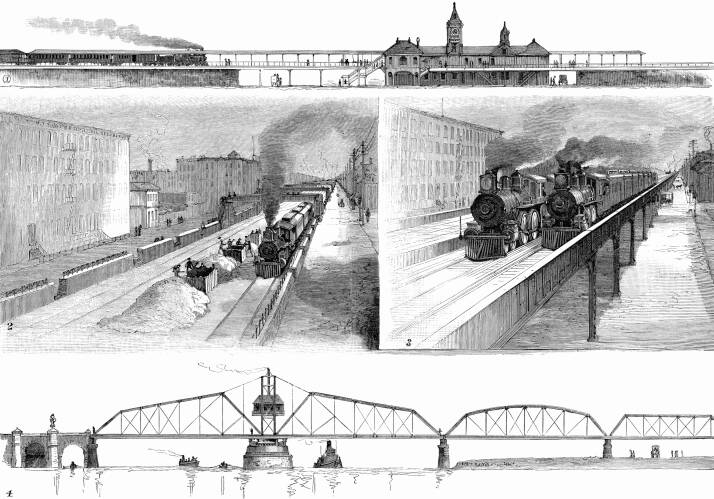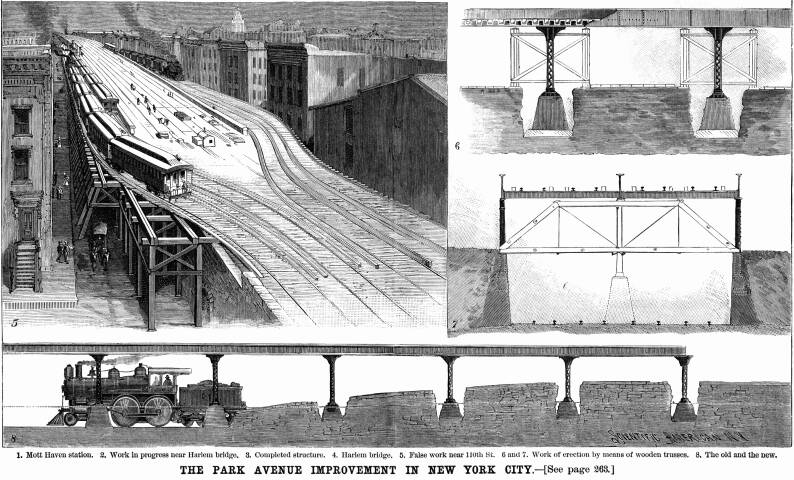|
SCIENTIFIC AMERICAN — April 28, 1894
This Article and 2 Illustrations
come from a time when The Bronx, NY was not consolidated into
the City of New York.
Mott Haven lies in The Bronx but was known then as part of the
Annexed District.
THE PARK AVENUE IMPROVEMENT IN
NEW YORK CITY.

The Grand Central Depot, at the corner of Fourth Avenue and
Forty-second Street, in this city, is the main railway terminus
on Manhattan Island, it is reached by four tracks on the line
of Fourth Avenue, running south from the Harlem River, The tracks
start from the street level at the Grand Central Depot, the entire
region about the depot being given up to the track yard, round-houses
and other structures appertaining to the railroad service. A few
blocks above Forty-second Street the streets crossing Fourth Avenue
are provided with bridges, but for a space of several blocks Fourth
Avenue cannot be crossed. At about Forty-ninth Street the tracks
begin to be depressed, and up to Ninety-eighth Street they run
virtually in a tunnel, over two miles long. This leaves the street
above unencumbered. The avenue is 140 feet wide, and through its
center and above the tunnel are a series of little parks, whence
the name of Park Avenue has been given to it. Trains passing through
the tunnel have an unobstructed track and do not reach the ground
level until they get to Ninety-eighth Street, Here the street
grade falls rapidly and the car tracks are carried on an elevated
viaduct of stone and earth filling. At 106th Street the work of
the Park Avenue Improvement Commission begins. It consists in
making connections to and in building a four-track elevated steel
viaduct from 110th Street to Mott Haven, where the tracks gradually
run down to the depressed road in the annexed district. The general
aspect of the finished structure is shown in Fig. 3.
The way is carried on three rows of lattice steel columns,
each row supporting plate girders. The intermediate cross trussing
is provided by the flooring, besides which there is a transverse
lattice girder for each set of columns. This is arranged on the
solid floor system, now in extensive use by the New York Central
Road on its bridges. A cross section of it is shown in Fig. 6.
It virtually consists of a series of three-sided box girders built
up of steel plates and angle irons. The plates are three-eighths
inch thickness, and the depth of the vertical plates averages
18 inches with a width of 14 inches. The channels thus formed
are open alternately above and below, and cover the entire area
with a water-tight floor. From center to center of cross space
the distance bridged by the girder floor is 28 feet, giving a
total width of floor of 56 feet, a plate girder running along
each side and one through the center. The girders are 7 feet 2
inches deep, and the webs are of three-eighths steel for the side
and 9-16 for the center girders. From center to center of columns
is 65 feet.
The street beneath the viaduct will be graded and paved, and
is to be thrown open to the public, leaving the full width, 140
feet between house lines, open and unobstructed, except by the
three rows of columns. The Harlem River is to be crossed on a
four-track high level bridge, with a center pier drawbridge. Immediately
across the river Mott Haven is entered, and here an elevated level
station is to be built. The Harlem River bridge is shown in Fig.
4, the Mott Haven station in Fig. 1.
One of the purposes in carrying out the improvement is to free
the street from the encumbrance presented by the stone viaduct
and to do away with bridges at street crossings. This is an object
of such importance as to justify the city in paying a part of
the expense. The use of an elevated bridge over the Harlem River
is also one of the most important features of the work. The river
in question is a legal waterway open to navigation. A low drawbridge,
such as in use at the present time, is not only an obstacle to
vessels, but the necessity for its periodical opening has interfered
with the running of the trains. The new bridge is to be so high
that the majority of vessels using the Harlem River can pass under
it. Thus, while it can be opened, it will be rarely that the necessity
for doing so will arise. The bridge, by its high level, will at
once improve the conditions of railroad and river traffic.
The system of carrying out the work without disturbance of
traffic remains to be described. In Fig. 5 is given a view of
the work of erection looking north from 107th Street. Here the
operations include removal of the viaduct now carrying the roadbed
and its replacement by the new structure. Temporary wooden trestle
work is to be built on each side of the present viaduct and on
this the trains are to run reaching the grade of the old road
at about 115th Street. This leaves the ground clear for the demolishing
of the old and erection of the new viaduct. When 115th Street
is reached, where the tracks begin for part of their extent to
be depressed, another system is adopted. The side columns are
put in place, as shown in Figs. 6 and 7. But the tracks being
all occupied, it is impossible to put in the center columns. Accordingly
wooden trusses are to be thrown across from the lines of the side
columns, and resting on the old retaining wall, and these trusses
provide a center bearing for the center longitudinal girder. In
this way, as also shown in Figs. 6 and 7, the full permanent flooring
is sustained by side columns and temporary transverse trusses.
The trains at this stage can run over the new tracks, definitely
abandoning the old. This leaves the ground clear for work. The
center piers will now be built, the columns will be erected on
them, and after the columns are in place the wooden trusses will
be removed.
This procedure it will be observed is adopted to keep four
tracks in use. But the temporary Harlem bridge will be a two-track
structure. For a short distance below it, therefore, the four
tracks are merged into two lateral ones, as shown In Fig. 2. This
leaves the scene unobstructed, and the viaduct can be built at
this place without any special methods of construction.
The sequence of the improvement provides, as said, for a four-track
elevated level bridge over the Harlem River. This in itself will
be an innovation, and will be the only four-track bridge of this
description in the world. To enable it to be built without interruption
of traffic, a temporary viaduct with a draw-opening has been erected
to the westward. The tracks will pass over this structure while
the main bridge is being erected. The temporary draw of the hinged
type, swung from horizontal to vertical position when opened,
is quite peculiar, and in itself is an object of interest. It
was about a year ago moved bodily from its position on the line
of the old bridge to its new location to the west. We illustrated
in the SCIENTIFIC AMERICAN of December 31, 1892, this operation,
one of remarkable interest, as being performed without interruption
of traffic, The same illustration may be referred to as showing
the old and new lines of road, the one where the new bridge is
to go, the latter for temporary use during the improvement.
In Fig. 8 we show the relations of the old to the new. The
locomotive is on the old tracks. Along the line are seen the side
columns, whose bases are on the street grade, and the side girders,
marking the viaduct bed, are seen resting on the columns.
The trussed flooring is to be riveted by means of angle clips
to the longitudinal central and side plate girders, The rails
are to be clipped to the flooring without sleepers, sound-insulating
or deafening pads being placed beneath them.
The steel structure is supplied by the Elmira Bridge Company
and the New Jersey Iron and Steel Company at a contract price
of $1,500,000. The masonry work of the piers, it is estimated,
will cost $100,000; the temporary work, $100,000; the Harlem pier
bridge, $1,000,000, and the work at Mott Haven. $500,000. This
aggregates over $3,000,000, of which amount the city of New York
is to pay $750,000.
The work is in the hands of a special commission appointed
by the Mayor, under a special act of the Legislature. It is entitled
the Board for the Park Avenue Improvement above 106th Street,
and includes the following members: John Fox, president; James
H. Haslin, secretary; Walter Katte, superintending engineer; Almerin
H. Lighthall, Peter F. Meyer.

Stories Page | Contents Page
|







